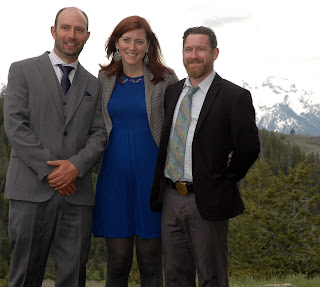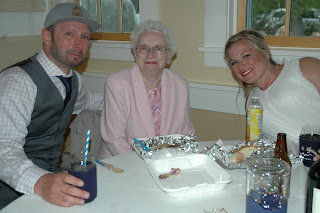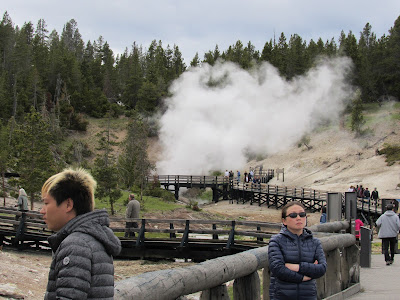The trip from Cody into Yellowstone was a bit of a challenge for our old truck. Pulling the camper over the steep grades made me feel sorry for how hard the Chevy had to work, but we made it just fine. The pass wound through majestic scenery which included miles of regenerating forest lands that still shows the scarred results of the 1988 wild fires that burned over 790 thousand acres. It was the largest forest fire ever recorded.
Our approach to the mountains
We had reservations to camp at Fishing Bridge campground. This is located at the north end of Yellowstone Lake. The famous "Fishing Bridge" crosses the Yellowstone River, which flows out of Yellowstone Lake The RV park has 325 sites, but fortunately for us it was the week before Memorial Day and most of the park was empty. The staff was gearing up for full occupancy after that weekend. We had an entire row to ourselves, with only one other camper in sight. We arrived around lunch time so we had a chance to check out a few places that afternoon.
There was a short boardwalk along some of the Yellowstone River rapids
Not a good place to canoe, but a fairly short portage.
A little plant art!
Buffalo were evident all along the roadsides. Usually in groups of three or four. We did not see many large herds this year. Must have been the time of year.
A scrub jay joined us on the boardwalk
That night James and Shellie arrived, after driving for the last four days, from Maine. We only had three days to see the park so we set out the next morning for Yellowstone Falls and the Grand Canyon of the Yellowstone River.
We drove to the south side of the canyon and took the one mile path toward Artists Point. The first view of the falls was amazing. We were looking down on the viewing platform, located just at the top of the falls, where the water crashes over the edge. The roar from the water was almost too loud to talk from where we were located. I can just imagine how loud it is down there.
The trail follows the very edge of the canyon. Hard to get any pictures that show the depth, colors, and many varieties of rock types in this canyon
Back on the road, we stopped at one of the first geothermal attractions where there was a large parking lot. This spot had several bubbling mud pots, boiling springs, and smoking water caves.
Seen from the parking lot, it looked very impressive.
and it was! The water boiled out of the cave along with billows of steam from the hot water.
Boiling water
and mud.
This sign explained how microorganisms use the sulfur gas, that comes out of the ground, as a source of energy, turning the gas into sulfuric acid. This acid then breaks down the rock into mud, which boils from the high temperature in the gas.
Later that day we traveled to the northern part of the park where Mammoth Hot Springs is located. This is the location of the park headquarters. The Visitors center and other administration offices are located in the buildings originally built in the early 1900 by the army when they were stationed here to protect the park wildlife and natural sites that were being damaged by poachers and others.
I thought these buffalo made great living lawn ornaments for this park residence.
I had not noticed the baby bison until I downloaded my pictures on my computer. They are cute enough to put in you SUV!
Mammoth Hot Springs is in a constant state of change. The hot springs differ from the geysers because the thermal water is under no pressure. The super heated water just flows continuously, creating ever increasing deposits of silica. The flow will occur in one location for awhile, then become blocked, only to ooze out some where else, creating a new deposit on the hill.
When the water finds a new location, the old deposits turn gray because the color is created by micro organisms that are only alive in the hot water.
From Mammoth, we traveled to the central area of the Park to have dinner and spend the night at the Old Faithful Inn. This Park Icon was built in 1903 during the Golden Age of rustic resort lodgings that were made of logs and stone. Considered the largest log structure in the world, it currently has 327 rooms. Additions to the original building were added in 1913, 1922, and 192,7 with many up-dates since then.
This great shot of the exterior I copied from Wikipedia. It was taken by Jim Peaco in 2003. I could only get single pieces of the building in any of my attempted shots. This photo is listed as public domain. It give a feeling of how huge the building is.
The lobby is dominated by the stone fireplace, which is 16 feet square at it's base and originally had 4 main hearths, one on each side, with n additional smaller hearths at each corner.
Just like the exterior, it is difficult to get a photo that portrays the size and beauty of the interior.
From the first balcony you can look over into the dining room below. Fortunately, we had made reservations for dinner, because there was a very long line of folks hoping to get a seat.
While we waited for the time of our dinner reservation, we sat on the second story deck that overlooks Old Faithful geyser.
I was sure I had a picture of us sitting there, as well as Old Faithful erupting, but not to be found. Somewhere in tech space, I'm sure.
Leaving Yellowstone Lake
Approaching the Grand Tetons
The next day we headed down to Jackson Hole and do some celebrating with the Duntons. Got a shot of James and Shell at this classic elk horn archway in downtown Jackson.




























































